From general business valuations to highly complex derivative securities, we help clients determine, account for and understand the fair value of their business interests for financial reporting and strategic decision-making. Our valuations are supported by robust analyses, thorough documentation and transparent reporting.
- Public and Private Businesses
- Complex Securities and Market Risk
- Mergers & Acquisitions
There are three major approaches to business valuation: income, market, or cost. We employ a combination of all methods to arrive at the most accurate conclusion of fair value to your organization.
The Income Approach involves valuation methods that convert future anticipated economic benefits (e.g., cash flow) into a single present-dollar amount. In techniques such as Discounted Cash Flow (DCF) analysis, a discount factor is applied to future benefits to account for the risk or uncertainty of achieving future results. Discount factors are usually derived from industry standard risk premiums for businesses with comparable size, industry, and other characteristics.
Our approach augments basic DCF with a probabilistic approach to estimating future cash flows. We develop ground-up models of future cash flows then systematically adjust the assumptions and inputs of these models to understand the distribution of possible outcomes. The result is a more nuanced understanding of the uncertainties in future cash flows and how they translate into discounting of baseline projections.
The Market Approach involves valuation methods that use market information on comparable businesses to help determine a company’s value. Such methods include the use of valuation multiples derived from guideline public companies or M&A transactions involving comparable private companies. This approach depends on identifying the right subset of companies or transactions and the most relevant valuation multiples and factors that apply to the business to be valued.
We leverage statistical modeling and large databases of public and private data to support our deep experience in market-based valuations. Classification algorithms help us to efficiently identify comparable businesses and transactions, and multiple regression analyses provide insight into which combinations of factors best indicate value.
The Cost Approach, also known as the asset-based approach, involves determining a company’s value by analyzing the market value of a company’s assets. This often serves as a valuation floor since most companies have a higher value as a going concern than they would if liquidated, i.e., the present value of future cash flows generated by the assets usually far exceeds the liquidation value of those assets.
Our approach augments basic DCF with a probabilistic approach to estimating future cash flows. We develop ground-up models of future cash flows then systematically adjust the assumptions and inputs of these models to understand the distribution of possible outcomes. The result is a more nuanced understanding of the uncertainties in future cash flows and how they translate into discounting of baseline projections.
Contingent consideration, also referred to as an earnout, is commonly used in mergers and acquisitions valuation practices to:
- Bridge a valuation gap
- Provide continuing incentive to business sellersAccount for the achievement of technical or other
- milestones
Acquirers must measure fair value on the acquisition date and again at each quarter so long as the contingent consideration exists as an asset or liability.
As a result, whatever effect the target company’s performance has on earnings can be tempered by an opposite (but not necessarily equal) impact on earnings.
We will help you:
- Identify the earnout that is part of a business combination or equity compensation
- Calculate the acquisition-date earnout valuation using appropriate modeling techniques, such as scenario-based models or Monte Carlo Simulations
- Measure the likelihood of attaining the earnout payoffs
- Re-measure assets and liabilities for each reporting date until the contingency is resolved
- Model the effects on future earnings under a variety of scenarios
- Prepare valuation reports and engage with your external auditors to provide audit support
- Gain greater visibility into the financial implications of earnouts while establishing a robust one-time or recurring valuation process
A convertible security is an investment that can be changed into another form. The most common are convertible bonds and convertible preferred stock, which can be converted into common stock.
A convertible security specifies the price at which it can be converted and pays a periodic fixed amount—a coupon payment for convertible bonds and a preferred dividend for convertible preferred shares.
Convertible securities valuation can be tricky. Since the securities are hybrid instruments (containing both equity and debt features), fair value needs to be measured upon issuance and may be required on a quarterly mark-to-market basis.
Even the slightest complexity within these instruments can create the potential for accounting surprises and unexpected earnings volatility.
We will help you:
- Develop fair value estimates for financial reporting purposes
- Test various mixes of stock and bonds for hedging convertibles
- Analyze how changes in parameters, such as share price or interest rate, can affect future valuations and their equity component
- Prepare valuation reports and engage with your external auditors to provide audit support
- Develop rigorous convertible debt valuations
- Manage uncertainty around future payouts
- Deploy a stable, repeatable process for your mark-to-market valuations

Agriculture

Chemicals

Financial Services

Life Sciences

Manufacturing

Oil & Gas

Power & Utilities

Public Agencies

Transportation

Renewables
1
2
3
4
5
6
Book a free 60-minute consultation with one of our experts to learn how we craft custom solutions for any business, at any stage of growth. It would be our honor to serve you.



